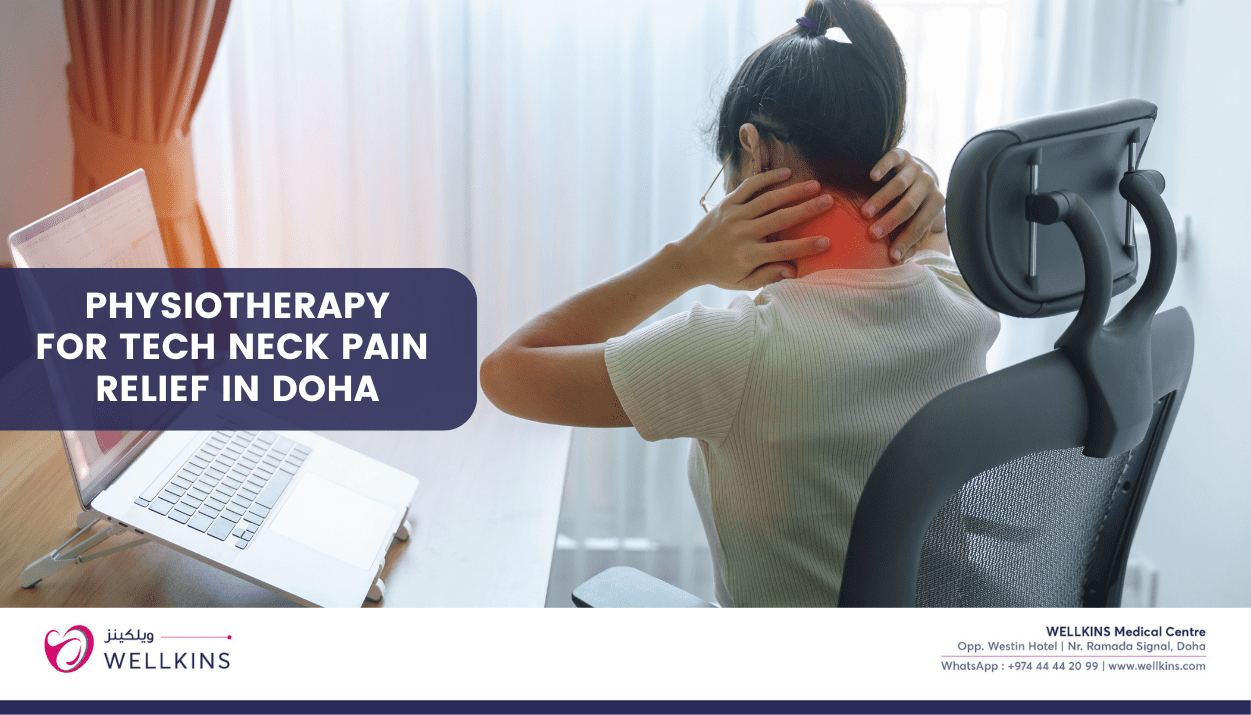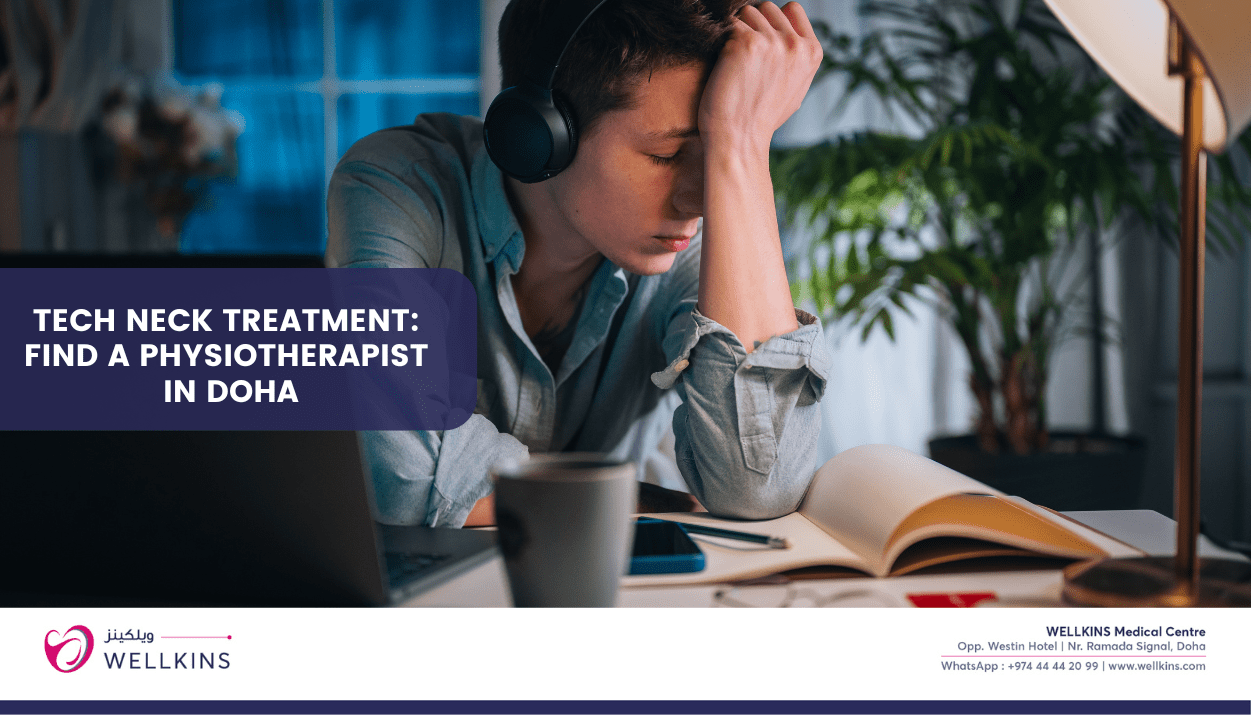Author: Ancy P Mathew (MSK Physiotherapist – WELLKINS Medical Centre)
In today’s digital world, prolonged use of smartphones, laptops, and tablets has led to an alarming rise in Tech-Neck Syndrome. This condition, caused by poor posture while using electronic devices, results in neck pain, stiffness, and even long-term spinal issues. With more people working remotely and increasing screen time, awareness and preventive measures are crucial to avoid chronic discomfort.
With the increasing use of smartphones and other handheld devices, many individuals are experiencing neck pain. This condition, commonly known as tech neck syndrome, is related to poor posture and the strain on the neck muscles from looking down at screens for extended periods. Physiotherapy can be an effective approach to manage and alleviate the discomfort associated with tech neck. Physiotherapy treatments may include exercises and stretches designed to strengthen the neck muscles, improve posture, and increase flexibility. Additionally, physiotherapists can provide practical tips and guidance on ergonomic adjustments to help prevent the onset or worsening of tech neck syndrome.
What is Tech-Neck Syndrome?
Tech-Neck Syndrome refers to neck pain and postural strain resulting from excessive forward head posture while using digital screens. When the head is tilted forward, it increases the strain on the cervical spine, leading to muscle imbalances and potential joint degeneration over time.
Causes of Tech-Neck Syndrome
Forward Head Posture: Every inch the head moves forward from its natural position adds excessive strain on the neck muscles.
Prolonged Screen Time: Extended periods of device use without breaks lead to poor posture and muscle fatigue.
Lack of Ergonomic Setup: Improper workstation setups contribute to awkward neck positions.
Weak Neck and Upper Back Muscles: Insufficient strength in supporting muscles makes it harder to maintain good posture.

Who is most at risk for Tech-Neck Syndrome?
Anyone who spends significant time on digital devices is at risk, including:
Office Workers: Sitting for long hours in front of a computer can exacerbate the condition.
Students: Long hours of reading, studying, or playing games on smartphones and tablets can be problematic.
Gamers: People who spend hours playing video games in poor postures are particularly prone to developing e-Neck Syndrome.
People with Sedentary Lifestyles: Those who spend much of their day sitting without moving or stretching are more likely to experience symptoms.
Preventive Measures for Tech-Neck Syndrome?
1. Maintain Proper Posture
Keep screens at eye level to prevent excessive forward head tilt.
· Sit with a straight back and shoulders relaxed.
· Use a chair with proper lumbar support to maintain spinal alignment.
2. Take Frequent Breaks
· Follow the 20-20-20 rule: Every 20 minutes, look 20 feet away for 20 seconds to reduce eye and neck strain.
· Stand up, stretch, and move around every hour.
3. Strengthening and Stretching Exercises
· Chin Tucks: Gently tuck your chin in and hold for a few seconds to strengthen deep neck muscles.
· Neck Stretches: Tilt your head to each side, forward, and backward to relieve tension.
· Shoulder Blade Squeezes: Pull shoulder blades together and hold for a few seconds to improve posture.
· Thoracic Extension Exercise: Arch your upper back slightly backward while keeping the lower back stable to counteract slouching
4. Ergonomic Adjustments
· Use a standing desk or an adjustable workstation to encourage movement.
· Position your monitor at eye level to prevent constant downward gaze.
· Hold your smartphone at chest or eye level instead of looking down.
When to Seek Physiotherapy?
If persistent neck pain, headaches, or reduced mobility affect your daily life, seeking physiotherapy can help. A physiotherapist can provide:
· Postural correction strategies
· Manual therapy to relieve muscle tension
· Customized exercise plans
· Workstation ergonomics guidance

When to Seek Physiotherapy?
If persistent neck pain, headaches, or reduced mobility affect your daily life, seeking physiotherapy can help. A physiotherapist can provide:
· Postural correction strategies
· Manual therapy to relieve muscle tension
· Customized exercise plans
· Workstation ergonomics guidance
Tech-Neck Syndrome is becoming increasingly common in the digital age, but with conscious efforts in maintaining posture, incorporating regular exercises, and making ergonomic adjustments, it is preventable. Prioritizing spinal health now will help in avoiding long-term complications and enhancing overall well-being.
If you are experiencing Tech-Neck symptoms, consider consulting a physiotherapist at Wellkins Medical Center. Our team will assess your posture and screen time habits and create a personalized treatment plan tailored to your needs. Whether through physiotherapy, posture correction, or ergonomic advice, we can help you manage and alleviate your discomfort, ensuring long-term neck and spine health.
At Wellkins, we’re committed to helping you maintain a healthy lifestyle, even in the digital age. Visit our Physiotherapy Department to learn more about Tech-Neck Syndrome and explore treatment options tailored to your needs.
Do you experience Tech-Neck symptoms? Share your thoughts in the comments and let us know how you manage screen time effectively!
Read more about the physiotherapy services at wellkins here: https://wellkins.com/physiotherapy/






